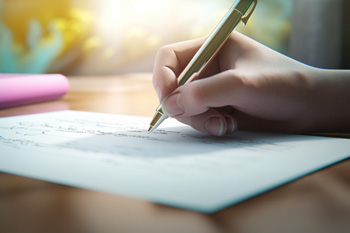The conveyancing process can be complex and time consuming, but it is an important part when you are selling or buying a property. In this guide we are going to go through our step-by-step timeline of the conveyancing process for both a seller and buyer.
What is conveyancing?
Conveyancing is the legal process of transferring the ownership of a property from one person to another. The conveyancing process takes around 8-12 weeks, but this can differ depending on circumstances. For example, if you are part of a chain the conveyancing process is likely to take longer. The conveyancing process for a seller and buyer is slightly different, so below we go through the steps involved for both.
Conveyancing timeline when selling a property
- Firstly, you need to instruct a conveyancer. Our blog post covers what you need to know before choosing one.
- The seller’s conveyancer will send the seller a letter with their fees and terms.
- The conveyancer will also carry out identity checks.
- Next, the conveyancer will send out the property information and fittings and contents forms.
- The seller will fill out the forms and send them back.
- The seller’s conveyancer will now get the title deeds from the Land Registry, and find out how much is outstanding on the seller’s current mortgage.
- The seller’s conveyancer will prepare the draft contract and supporting documents and then send them to the buyers conveyancer.
- The buyer’s conveyancer will look over the contract and report back to the seller’s conveyancer with any questions.
- The seller and conveyancer should then answer the questions.
- The buyer and the buyer’s conveyancer will then say if they are happy with the answers to the questions, searches and if they have had the mortgage offer through.
- Exchanging of contracts happens next making the sale legally binding.
- Next, the seller’s conveyancer will need to get the settlement figure, to ensure any outstanding mortgage payments get paid.
- The seller’s conveyancer should now have received the transfer deeds, checked them over and sent to the seller.
- On completion day the seller will need to leave the property and hand over the keys.
- Next, the buyer’s conveyancer will need to send the funds to the seller’s conveyancer.
- The keys are released for the buyer.
- Then the seller’s conveyancer will send the buyer’s conveyancer the transfer deed and title deed.
- The seller’s conveyancer will now use the funds from the sale to pay any fees. And pay any outstanding mortgage payments.
- The seller’s conveyancer can now transfer them the rest of the funds.
Conveyancing timeline when buying a property
- The buyer will need to have their offer accepted on the property.
- Then instruct a conveyancer.
- The buyer arranges a property survey. And if needed applies for a mortgage. You can read our guide to applying for a mortgage here.
- The buyer’s conveyancer will send a letter outlining terms and fees.
- The buyer’s conveyancer will get the contract pack off the seller’s conveyancer.
- The buyer’s conveyancer check’s the contract pack, conduct’s searches, prepares questions regarding the contract pack and get’s a copy of the mortgage offer.
- Next, the buyer’s conveyancer should receive answers from the seller’s conveyancer to the questions they had about the contract pack.
- The buyer’s conveyancer informs the buyer of the results from the searches, answer’s received regarding the contract pack plus it’s contents and is shown a copy of the mortgage offer.
- If the buyer is happy the buyer’s conveyancer can receive the deposit.
- The contracts are exchanged and a completion date is set.
- A draft of the transfer deed and completion information forms are prepared by the buyer’s conveyancer, and sent to the seller’s conveyancer.
- The seller’s conveyancer will check the transfer deed and completion information forms, and make a final copy.
- The buyer’s conveyancer will draft a completion statement.
- The pre-completion searches can be carried out and the buyer’s conveyancer will make sure the mortgage lender receives the final application.
- On completion day the seller will need to leave the property and the proceeds from the sale will be transferred from the buyer’s conveyancer to the seller’s conveyancer.
- The seller’s conveyancer will release the keys.
- Next, the buyer’s conveyancer should receive the transfer and title deeds, and proof that they will pay any existing mortgage.
- The buyer’s conveyancer will send HMRC any stamp duty tax. We cover all about stamp duty here.
- The buyer’s conveyancer receives the transfer and title deeds, along with proof that the seller has paid any outstanding mortgage.
- The buyer’s conveyancer uses Land registry to register the property in the buyers name.
- The Land Registry will send the buyer the registered title copy.
- Lastly, if there is any documents the mortgage lenders needs, the conveyancer will pass them on.
Searches the conveyancer may do
As briefly mentioned above the conveyancer will conduct searches during the process. These searches are:
- Local authority searches – this search will find out if planning permission has ever been granted or if it has been refused before. As well as, any information about past work done to the property, buildings regulations certificate and any pollution or highway issues.
- Environmental search- they will need to check how stable the ground is, is there flooding risks? Or if there are any landfill sites or contamination issues?
- Land registry searches- they do this so they can check who the legal owner of the home is.
- Water and drainage searches- they will want to check if the property has a public water supply or sewer connected to it, who owns the drains, sewers and pipes, and who will be maintaining them. As well as, where abouts the drainage pipes and public sewer are in relation to the property.
What documents you may need during the conveyancing process?
There are a few documents you need during the process, your conveyancer should help you with these documents:
- Title deeds – they show who owns the property, both a seller’s and buyer’s conveyancer will look at these.
- Property information form (TA6 form) – the seller fills out this form and gives it to the buyer.
- Fittings and contents form (TA10 form) -this form tells the buyer what is going to left in the property for them.
- Energy Performance Certificate (EPC) – you must have an EPC by law to sell your home. You may already have one as they are valid for ten years, but if not your conveyancer can help you get one. We cover everything you need to know about an EPC in our blog post.
- Proof of identity – you will either need ID or passport to prove your identity, this for both a seller and buyer.
- Management information pack – this pack will contain different important documents passed over to the buyer’s conveyancer to help the buyer make a decision on whether to proceed with the sale.
- Warranty- if you home is a new build then you should have warranty documents.
- Stamp duty receipt – when you pay stamp duty you should get confirmation.
- Indemnity insurance – your conveyancer may suggest you getting indemnity insurance. The reason for this is because if there are any problems with the home in the future that would cost you, then indemnity insurance would protect you from this.
- FENSA certificate – if you have had double glazing installed in your home you should have a FENSA certificate. This is to show the new windows adhere to building regulations.
- Electrical certificate – as a seller you will need to provide the electrical certificate so the buyer knows the electrics are safe.











